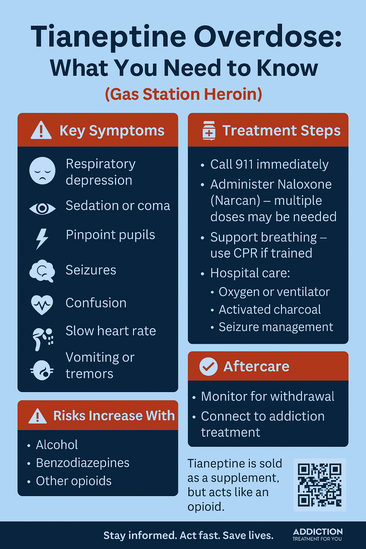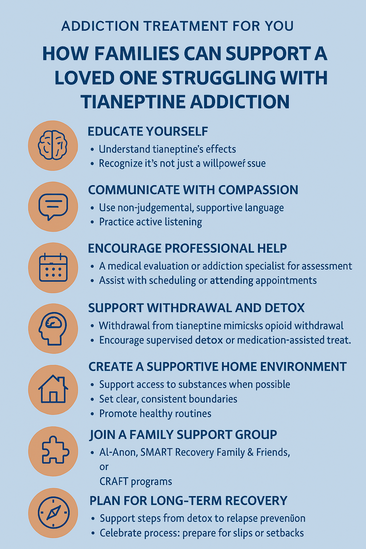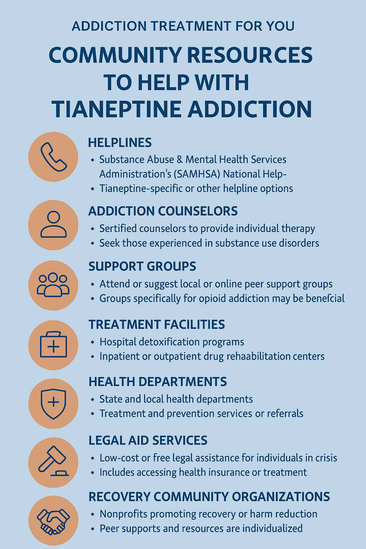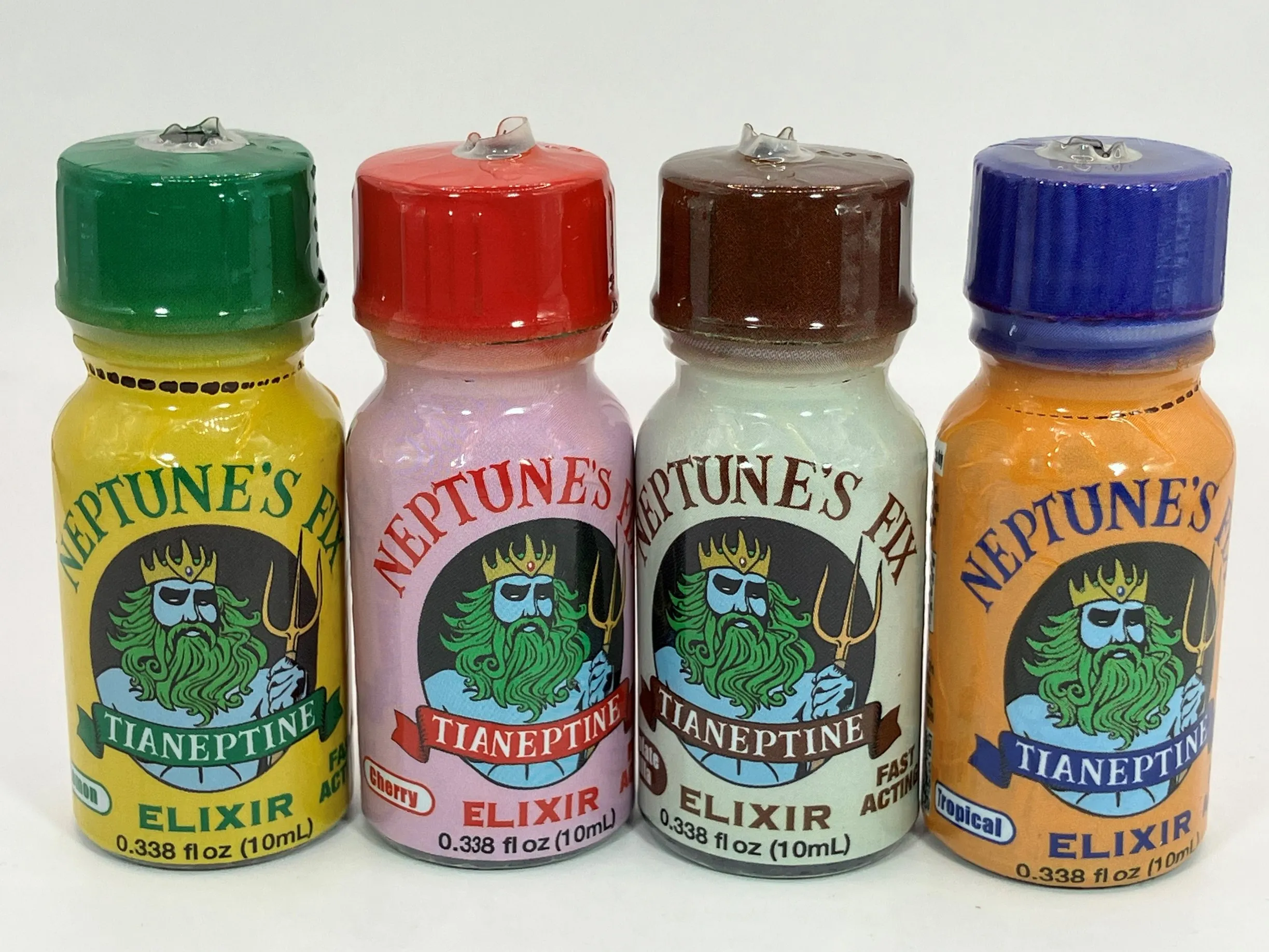Tianeptine, sold under names like ZaZa or Tianna Red, is a highly addictive drug with opioid-like effects. Though marketed as a supplement, it can cause tolerance, withdrawal, and overdose, with symptoms like sedation, slowed breathing, and seizures. Addiction develops through repeated use and brain changes similar to opioid dependency. Treatment includes naloxone, supportive care, and withdrawal management. Recovery is strengthened through family support and access to community resources like peer support, treatment programs, and education.
“Gas Station Heroin”: The Hidden Dangers of Tianeptine Sold Over the Counter
🧪 What Is Tianeptine?
“Gas station heroin” is a street name for tianeptine, a controversial substance often sold in gas stations, vape shops, or convenience stores in the U.S. under names like ZaZa, Tianna Red, or Neptune’s Fix. Though it’s often marketed as a nootropic or dietary supplement, tianeptine can act like an opioid at high doses—leading to addiction, withdrawal, and even overdose.
- Originally developed as an antidepressant in Europe and parts of Asia.
- Not approved by the FDA for use in the U.S.
- At high doses, it acts on mu-opioid receptors, similar to heroin or fentanyl.
⚠️ Why Is It Dangerous?
While some users turn to tianeptine to manage anxiety, depression, or even opioid withdrawal, it poses serious risks:
- Can cause euphoria, calmness, and sedation—fueling misuse.
- Leads to physical dependence and withdrawal symptoms.
- Associated with seizures, cardiac complications, and overdose, especially when combined with other drugs or alcohol.
- Users often escalate doses to replicate opioid-like effects, increasing danger.
🚨 Withdrawal and Addiction
Tianeptine withdrawal can closely mirror opioid withdrawal, including:
- Nausea, sweating, muscle pain, and insomnia
- Heightened anxiety, mood swings, and cravings
- Reports of severe dependency and frequent relapse patterns are growing
🏛 Regulatory Response
- As of 2024, states like Michigan, Tennessee, and Alabama have officially banned tianeptine.
- The FDA has issued multiple public warnings.
- Poison control centers are receiving a rising number of calls related to tianeptine exposure.
In summary, tianeptine—marketed under harmless names and sold in everyday places—is far from safe. Nicknamed “gas station heroin” for a reason, it mimics the effects and risks of traditional opioids. With its loose regulation, addictive potential, and easy access, it’s becoming a new front in the fight against substance misuse.
If you or someone you know is using tianeptine, seek medical support. Awareness and early intervention can prevent long-term harm.
The Hidden Danger of Tianeptine: How a Legal “Supplement” Mimics Opioid Addiction
🚨 Tianeptine Use on the Rise in the U.S.
Tianeptine use is growing rapidly in the United States because it produces opioid-like effects while remaining legal or loosely regulated in many areas. Although it was originally developed as an antidepressant, tianeptine’s unique pharmacology and easy access have made it a substance of abuse—especially among individuals seeking relief from depression, anxiety, or opioid withdrawal.
🧠 Why People Use Tianeptine
- Mood enhancement and self-medication: Used to treat depression or anxiety when professional care is inaccessible.
- Euphoric and sedative effects: At high doses, it activates mu-opioid receptors, producing heroin-like highs.
- Accessibility: Readily available at gas stations, vape shops, and online, often disguised as a “nootropic” or wellness supplement.
🧬 Pathology of Tianeptine Addiction
1. Opioid Receptor Activation
- Therapeutic doses affect serotonin modulation.
- At higher doses, tianeptine directly stimulates mu-opioid receptors, leading to:
- Euphoria
- Reinforcement of use
- Tolerance and dependence
2. Rapid Tolerance
- Users build tolerance quickly, needing more to feel the same effects.
- Leads to frequent redosing, mimicking the cycle of opioid addiction.
3. Withdrawal Syndrome
- Stopping use causes severe symptoms:
- Anxiety, tremors, sweating, nausea, diarrhea, and insomnia
- Intense cravings and relapse
- Symptoms are nearly identical to opioid withdrawal.
4. Neuroadaptation and Dysregulation
- Long-term use damages natural brain reward systems, affecting mood and stress responses.
- Leads to compulsive use, emotional distress, and decreased daily functioning.
⚠️ Who’s Most at Risk?
Tianeptine misuse often affects people with:
- Mental health conditions like depression, anxiety, PTSD
- A history of opioid or polysubstance use
- Limited access to medical or behavioral health care
- False beliefs about the drug being “safe” because it’s sold legally
📉 Why This Matters
Tianeptine addiction follows the classic opioid pattern:
Reward → Tolerance → Withdrawal → Compulsive Use
But unlike heroin or fentanyl, tianeptine hides behind:
- Legal loopholes
- Unlabeled or deceptive packaging
- Lack of regulation and public awareness
It’s not detected on standard drug screens, making diagnosis and treatment harder for healthcare providers. This makes tianeptine a silent threat in communities already struggling with addiction and limited access to care.
In summary, tianeptine’s rise in popularity is a red flag in the opioid epidemic’s evolving landscape. If you or someone you know is misusing tianeptine, seek medical help. Awareness, accurate information, and policy reform are critical to stopping this hidden wave of addiction.
Tianeptine Overdose: Symptoms, Emergency Treatment, and What You Need to Know
🧠 Symptoms of Tianeptine Overdose
Tianeptine overdose can mirror the effects of opioid overdose, with additional symptoms unique to its chemical profile:
- Respiratory depression (slow or shallow breathing) — a life-threatening sign
- Extreme sedation or coma
- Pinpoint pupils (miosis)
- Confusion or altered mental status
- Low blood pressure (hypotension)
- Slow heart rate (bradycardia)
- Nausea and vomiting
- Seizures (rare, but reported in high doses)
- Muscle rigidity or tremors
- Loss of consciousness
🚨 Treatment of Tianeptine Overdose
1. Emergency Medical Care
- Call 911 immediately if overdose is suspected.
2. Supportive Care
- Secure airway, breathing, and circulation (ABCs)
- Provide oxygen or ventilation if needed
- Monitor vital signs continuously
3. Naloxone (Narcan) Administration
- Naloxone can reverse opioid-like respiratory depression
- Multiple doses may be required due to tianeptine’s long-acting effects
4. Activated Charcoal
- If taken within the past hour, it may reduce absorption
5. Seizure Management
- Treat with benzodiazepines as needed
6. Cardiovascular Monitoring
- Monitor and manage blood pressure and heart rate
7. Observation and Withdrawal Support
- Close monitoring is needed for delayed symptoms and emerging withdrawal
⚠️ Important Notes
- There is no specific antidote for tianeptine; naloxone only addresses opioid-like effects
- Risk of overdose increases when combined with alcohol, benzodiazepines, or other CNS depressants
- After stabilization, assess for addiction treatment and withdrawal management
In summary, tianeptine overdose is dangerous, unpredictable, and often underrecognized in emergency settings. Its opioid-like effects—paired with easy access and loose regulation—make it a growing threat. Rapid intervention saves lives, but follow-up care is crucial for long-term recovery.
How Families Can Support a Loved One Struggling With Tianeptine Addiction
Tianeptine addiction—often referred to as “gas station heroin”—can be devastating not just for the individual, but also for their family. Because it’s legally sold in many places and marketed as a supplement, its dangers are often misunderstood or underestimated. As a family member, you play a crucial role in helping someone find a path to recovery. Here’s how to support them with compassion, knowledge, and stability.
🧠 1. Educate Yourself About Tianeptine
Understanding how tianeptine works is key. Though originally developed as an antidepressant, it can act like an opioid at high doses, leading to:
- Physical dependence
- Severe withdrawal symptoms
- Behavioral changes
The more you understand the drug’s effects, the better equipped you’ll be to offer informed, empathetic support.
🗣 2. Communicate Without Judgment
Speak openly, calmly, and without blaming. Say:
- “I’m concerned about your health.”
- “How can I support you?”
Avoid statements like: “You just need to stop,” or “You’re being selfish.”
Active listening, reflective responses, and open-ended questions create safety and trust.
🏥 3. Encourage Professional Help
Help your loved one find:
- An addiction medicine provider
- A therapist experienced in substance use
- Detox or treatment programs that understand unregulated substances like tianeptine
Offer to help with appointments or transportation if needed.
😣 4. Support During Withdrawal
Tianeptine withdrawal can mimic opioid withdrawal with symptoms like:
- Nausea, anxiety, muscle aches, and insomnia
- Cravings and emotional instability
Create a safe, calm environment. Encourage rest and hydration. If symptoms are severe, seek medical help or detox services.
🧠 5. Address Underlying Mental Health Issues
Many people misuse tianeptine to self-medicate:
- Depression
- Anxiety
- PTSD
- Opioid withdrawal
Encouraging access to mental health care is crucial for lasting recovery.
🏡 6. Create a Supportive Home Environment
- Remove triggers (like cash, pill bottles, or online access to tianeptine)
- Set clear, respectful boundaries around drug use at home
- Promote daily structure—meals, sleep routines, outdoor time
Routine and predictability help stabilize emotions during recovery.
🤝 7. Get Support for Yourself
You don’t have to carry the burden alone. Join a family-focused support group like:
- Al-Anon
- SMART Recovery Family & Friends
- CRAFT-based programs (Community Reinforcement and Family Training)
These communities can teach you how to help without enabling.
💬 8. Use Language That Reduces Stigma
- Say: “They’re dealing with a substance use disorder.”
- Avoid: “They’re an addict.”
Use person-first language and affirm that addiction is a medical issue, not a moral failure.
🧭 9. Plan for Long-Term Recovery
Recovery takes time and may involve:
- Relapse prevention planning
- Ongoing counseling or support groups
- Rebuilding trust slowly
Celebrate progress—no matter how small—and be prepared for setbacks with compassion, not criticism.
In suimmary, tianeptine addiction is real, serious, and growing—but family support can make all the difference. By offering education, boundaries, empathy, and encouragement toward treatment, you become a powerful part of your loved one’s recovery.
Remember: You don’t have to do it alone. Seek resources, ask for help, and believe that healing is possible—for them and for you.
Community-Based Strategies to Help People Struggling with Tianeptine Addiction
Tianeptine—often sold under names like ZaZa, Tianna Red, or Neptune’s Fix—is emerging as a dangerous, unregulated drug with opioid-like effects. Despite being marketed as a supplement, it carries a serious risk of addiction, overdose, and withdrawal.
While families play a critical role in supporting recovery, communities are essential in creating safe environments, support networks, and pathways to treatment. Here’s how communities can step up and respond to this growing threat:
🔗 1. Connect People to Local Addiction Treatment Services
- Many clinics and addiction recovery centers now treat non-traditional substances like tianeptine.
- Services may include medically supervised detox, counseling, and medication-assisted treatment (MAT).
- Community health centers often offer care on a sliding scale or at no cost.
📍 Try resources like:
- SAMHSA Treatment Locator
- Local public health or behavioral health departments
🤝 2. Support Through Peer Recovery Programs
- Peer support specialists, often in recovery themselves, help bridge the gap between addiction and treatment.
- They offer:
- Emotional support and relapse prevention coaching
- Help with appointments, transportation, and paperwork
- Connection to housing and basic needs
Available at Recovery Community Organizations (RCOs) or through local non-profits.
📚 3. Provide Education and Harm Reduction Resources
- Host public education events to raise awareness about the risks of tianeptine use.
- Distribute:
- Flyers in vape shops, clinics, or libraries
- Naloxone (Narcan) kits and training—even for legal substances like tianeptine
- Info on how to recognize overdose symptoms
Community health fairs, school meetings, and shelters are great outreach opportunities.
☎️ 4. Expand Hotlines and Mobile Crisis Support
- Ensure your local crisis hotline can assist people affected by tianeptine use.
- Promote services that offer:
- 24/7 support
- Links to detox and mental health care
- Mobile units that respond to non-violent drug crises
Training hotline staff to understand tianeptine is key to effective response.
🧾 5. Engage Local Businesses in Awareness
- Partner with vape shops, gas stations, and convenience stores to:
- Display warning posters or referral cards
- Avoid selling products with known abuse potential
- Refer customers to recovery resources when appropriate
Creating public–private partnerships can reduce local harm and stigma.
🚐 6. Offer Transportation and Case Management Support
- Lack of transportation is a major barrier to addiction care.
- Community programs can:
- Provide free ride programs, bus passes, or volunteer driver services
- Assign case managers to help coordinate recovery steps
This is especially important in rural or low-income areas.
🧑🏫 7. Involve Faith-Based and Cultural Groups
- Many people trust faith leaders or cultural elders more than institutions.
- Partner with churches, mosques, or tribal health programs to:
- Host support groups
- Offer spiritual or culturally relevant counseling
- Break stigma with compassion-based education
🏠 8. Create Welcoming Recovery Spaces
- Drop-in recovery centers provide:
- Sober social spaces
- Peer groups and activities
- Job and education assistance
These environments reduce isolation and offer hope and purpose.
📣 9. Push for Policy Change
- Advocate for:
- Local bans or restrictions on unregulated tianeptine products
- More funding for community-based treatment programs
- Expanded Naloxone access and education initiatives
Public health departments, recovery coalitions, and neighborhood groups can work together to advocate for safer, healthier communities.
In summary. Tianeptine addiction is a community issue, not just a personal one. It requires compassionate action, informed partnerships, and shared responsibility. Whether you’re a healthcare provider, faith leader, educator, or concerned resident, you can be part of the solution.
Community connection saves lives. Together, we can reduce harm and help more people recover with dignity.
Frequently Asked Questions
Here are some common questions:
Question: Provide printable infographic poster for awareness campaigns.
Answer:

Question: Provide printable infographic poster for family support awareness campaigns
Answer:

Question: Provide printable infographic poster for community resources awareness campaigns
Answer:

Conclusion
Tianeptine is a unique substance with addictive potential that affects brain chemistry in ways distinct from typical opioids, yet it can lead to serious dependency and withdrawal symptoms. Its pathology involves alterations in neurotransmitter systems, contributing to mood changes and physical dependence. Overdose symptoms often include respiratory depression, confusion, and severe sedation, requiring prompt medical intervention. Effective treatment combines medical detoxification, behavioral therapy, and ongoing support. Crucially, family support and community resources play a vital role in recovery by providing emotional encouragement, education, and access to rehabilitation services. Together, these strategies create a comprehensive approach that enhances the chances of sustained sobriety and improved quality of life for those affected by Tianeptine addiction.
